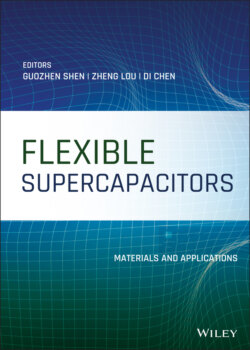Читать книгу Flexible Supercapacitors - Группа авторов - Страница 23
1.4 Summary
ОглавлениеTo conclude, AFSCs have been universally accepted as one of the most promising energy storage devices, which effectively utilize the different potential windows of the pseudocapacitive cathodes and electric double‐layer capacitive anodes to increase the operating voltage of the device, thus contributing to the significant boosting of their energy density. Furthermore, researchers have developed AFSCs with impressive lightweight, small size, and high flexibility to satisfy the growing demand of portable/wearable electronics. Many novel and efficient configurations have been designed for easy integration with textiles and miniature electronics.
Still, enormous effort should be paid to the future improvement and popularization of AFSCs. Firstly, further optimizing the overall electrochemical performances of the flexible electrodes and the devices remains as the biggest obstacle for AFSCs. Although the employment of pseudocapacitive anodes could well improve the limited energy density of AFSCs due to the relatively low capacitance of carbon‐based anodes, their poor conductivity results in unsatisfactory power density, which is worth more effective solutions. Secondly, the fabrication of a high‐mass‐loading electrode with good electrochemical performances and simultaneously good mechanical properties is rather challenging. Thirdly, most of the AFSCs are arduously handmade, which is difficult for industrial scale‐up with machines. Finally, the smart integration of AFSCs as power sources with energy harvesting units (solar cells, fuel cells, nanogenerators, etc.) or energy consuming units (sensors, LEDs, displays) would be a promising strategy for rational arrangement and utilization of energy, which is accordant with the future goals of sustainable development.
Figure 1.10 (a) Schematic diagram of the fabrication procedure of an AFSC. (b) Digital images of an AFSC woven into a glove at different bending states. (c) CV curves of solid‐state AFSC at different bending states with a scan rate of 100 mV s−1. (d) Digital images of the stretchable AFSC before and after stretching. (e) Capacitance ratio of the AFSC under different applied strains (0%, 10%, 20%, 40%, 60%, 80%, and 100%) at a scan rate of 100 mV s−1. Inset shows the CV curves of the AFSC measured at different applied tensile strains.
Source: Reproduced with permission [118]. © 2015, Elsevier.
